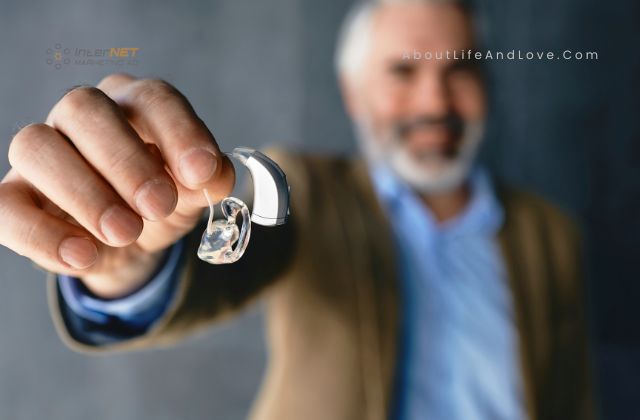With hearing loss affecting millions due to rising noise pollution and health concerns, seeking solutions becomes crucial. Hearing aids can significantly improve your quality of life, yet many misconceptions prevent people from utilizing them. Let's debunk these common myths and misconceptions about hearing aids to empower you to make informed decisions for your hearing health.
1. Not everyone with hearing problems needs them.
It is common for patients to treat the problem lightly and avoid wearing hearing aids until they can. However, even mild issues should be addressed seriously, as they can disturb daily life. So, you should invest in these devices as soon as your audiologists recommend them.2. Hearing aids make the sounds too loud.
Another false belief about hearing aids is that they amplify sounds to such an extent that they become too loud. With analog aids, soft d sounds and low-frequency and high-frequency sounds are amplified equally. This means that they can get a little bit of the noisier side. However, with the popularity of digital signal processing technology for these instruments, they can now be tailored according to individual needs.3. They are bulky and uncomfortable.
Years ago, hearing aids were large, making them bulky and uncomfortable. However, the devices have evolved with time and the advent of new technologies. Today, you can find ones that are larger in size and even hard to detect as they fit right into your ear canal. The comfort they offer is far better, too.4. An invisible hearing aid is the best.
As the variety of hearing aids on the market increases, so do the myths and misconceptions about them. Many people will try to convince you that invisible instruments are better than visible ones. However, the only thing that makes them better is their aesthetic value. Your doctor is the right person to decide which device is best for your hearing problem, and can recommend whether something like these oticon intent hearing aids would benefit your hearing impairment and struggles.
5. They can restore the hearing function back to normal.
It's tempting to believe these devices could help you regain normal ear functions. But this is one of the many misleading myths about hearing aids. Hearing aids are no magic. They can help you hear better but do not restore hearing to normal. They can improve your quality of life and help you deal better with social situations.6. You need to wear only one hearing aid.
Another misconception about hearing aids is that you must wear only one to hear correctly. You need to hear well with both ears, just as you need to see well with both eyes. Wearing them on both ears helps you hear comfortably, even in the noisiest places.
7. Everyone can wear the same kind of hearing aids.
The one-size-fits-all approach is not suitable for those who need to wear these devices. Every patient has a different problem and a varying level of hearing loss. Similarly, the shape of the ears and dexterity issues determine the kind of aids that would work in your case. So, it is better to see an audiology doctor so that he can help you choose the type that works for you.8. Hearing aids always help the patient hear better despite the background noise.
Once you have the right aids fitted, you may expect to hear loud and clear, even in loud background noise. However, their effectiveness depends on several factors, such as the noise intensity. Strategies such as adaptive directional microphones and noise cancellation algorithms can maximize the impact.
9. Hearing aids make you appear handicapped.
New invisible hearing aids are now available, which can help people hear without appearing elderly or disabled. Completely-in-the-canal (CIC) aids are the best option for those who want to hear normally without being noticed.10. Hearing aids are always expensive.
Hearing aids might seem like an expensive treatment option, but you can purchase them by shopping online from trusted sites such as myearhorn.com. Always ensure that you pick the best quality and the correct battery specifications. Also, check for an optimal warranty period.
7 Benefits of Hearing Aids
Hearing aids are a form of treatment for various types of hearing loss, particularly sensorineural hearing loss, the most common type. Here are other ways hearing aids can benefit you:
- Enhanced Conversations: Hear loved ones clearly and participate fully without straining.
- Reduced Social Isolation: Reconnect with friends and family, boosting social well-being.
- Improved Mental Clarity: Reduced hearing effort can sharpen focus and memory.
- Increased Safety: Better awareness of sounds like alarms and traffic signals.
- Boosted Confidence: Engage confidently in social and professional settings.
- Improved Overall Health: Studies suggest hearing aids may even benefit brain health.
- More Enjoyable Activities: Appreciate music, movies, and nature sounds to the fullest.
How to Choose Hearing Aids: A Quick Guide
Finding the right hearing aids involves a few key steps:
- Schedule a hearing test: An audiologist will assess your hearing loss and recommend suitable options.
- Consider your lifestyle: Discuss listening environments (quiet vs. noisy) and desired features (directional microphones, Bluetooth connectivity).
- Evaluate styles: Explore options like behind-the-ear (BTE) or in-the-ear (ITE) styles based on comfort and preferences.
- Think about features: Decide on functionalities like noise reduction, automatic volume control, or tinnitus masking.
- Discuss budget and insurance: Explore financing options and inquire about insurance coverage for hearing aids.
Strategies to Support Healthy Hearing (Not a Substitute for Hearing Aids)
While there's no guaranteed way to improve hearing naturally once it's lost, several strategies can support your overall hearing health:
- Protect your ears: Limit exposure to loud noises and use ear protection in noisy environments.
- Manage stress: Chronic stress can worsen hearing problems. Relaxation techniques like yoga or meditation may be beneficial.
- Maintain a healthy diet: Ensure a balanced diet rich in vitamins and minerals essential for ear health. Consider including foods rich in B vitamins, magnesium, and potassium.
- Earwax removal: Follow safe practices to remove excess earwax buildup, which can temporarily impact hearing.
- Regular hearing checkups: Schedule regular hearing tests with an audiologist to monitor your hearing health and detect any changes early on.
Remember: These strategies can't reverse hearing loss but might help prevent further deterioration and promote overall ear health.
If you experience hearing difficulties, consulting a hearing healthcare professional is crucial to determine the best action, including exploring hearing aids if necessary.
Hearing Aids for Age Groups
Pediatric Hearing Aids
Infants and Toddlers
These hearing aids are specially designed to be small, lightweight, and durable, considering the active nature of babies and toddlers. They often come with features like tamper-resistant battery doors and water resistance.
Children and Adolescents
Hearing aids may offer more customization options for older children and teenagers to meet their specific hearing needs. They may also include features to help with school activities, such as telecoil for better classroom hearing and connectivity with other devices like smartphones.
Adult Hearing Aids Types
Hearing aids come in various styles, each with its own advantages:
- Standard Behind-The-Ear (BTE): This common type suits many adults. It sits comfortably behind the ear and connects to a custom earpiece that fits in the ear canal.
- Receiver-in-Canal (RIC) or Receiver-in-the-Ear (RITE): This is similar to BTE but has a smaller and more discreet receiver inside the ear canal. It provides a more natural sound experience.
- In-The-Ear (ITE) or In-The-Canal (ITC): These hearing aids are custom-made to fit entirely inside the outer ear (ITE) or partially in the ear canal (ITC). They're less visible but may not be suitable for severe hearing loss.
- Completely in-canal (CIC) or Invisible-in-canal (IIC) hearing aids are the smallest and most discreet, fitting entirely inside the ear canal. They offer cosmetic advantages but may have limitations regarding battery life and power.
Senior Hearing Aids
Seniors often use the same types of hearing aids as adults. Still, they may have additional features catering to their lifestyle needs, such as enhanced telecoil options for better compatibility with hearing loop systems commonly found in theaters and churches.


Specialized Hearing Aids
Beyond the standard styles, consider exploring specialized options. These innovative devices cater to mild-to-severe hearing loss with unique 4D Sensor technology. This technology allows the hearing aid to understand and adapt to your specific listening environment and intentions.
- Bluetooth and Wireless Connectivity: Many modern hearing aids, regardless of age group, come with Bluetooth and wireless connectivity features. These allow users to stream audio directly from smartphones, TVs, and other devices, enhancing their listening experience.
- Rechargeable Hearing Aids: Rechargeable options are becoming increasingly popular across all age groups due to their convenience. They eliminate the need to replace disposable batteries frequently.
How much does a hearing aid cost?
The cost of hearing aids can vary depending on technology level, features, and brand. Here's a general range:
- Average cost per hearing aid: $1,000 - $3,500
- Typical cost for a pair: $2,000 - $7,000
Additional factors affecting the price
- Advanced features: Bluetooth connectivity, directional microphones, and tinnitus masking can increase cost.
- Customization: Custom earmolds may add to the price.
- Audiologist services: Hearing tests, programming, and follow-up appointments may incur fees.
Can I afford a hearing aid?
Let's explore affordability.
- Insurance coverage: Some insurance plans offer partial coverage for hearing aids.
- Financing options: Many hearing healthcare providers offer financing plans.
- Manufacturer discounts: Check manufacturer websites for special offers or discounts for specific demographics (e.g., veterans).
- Government programs: Certain government programs might offer assistance for low-income individuals.
Debunking Myths and Misconceptions About Hearing Aids
Hearing is a critical body function. Even a mild compromise in this ability can hamper quality of life. Hearing aids are assistive listening devices that amplify sound, not a natural solution. Consult an expert to suggest what works best for you. Also, ask them the right questions to clear up the myths and misconceptions about hearing aids.

























1 comments
I have a great uncle who wears a hearing aid and he still has hearing problems - you're definitely right about it not curing everything but being helpful. And they can come in all forms and shapes and sizes! Loved this list.
ReplyDelete